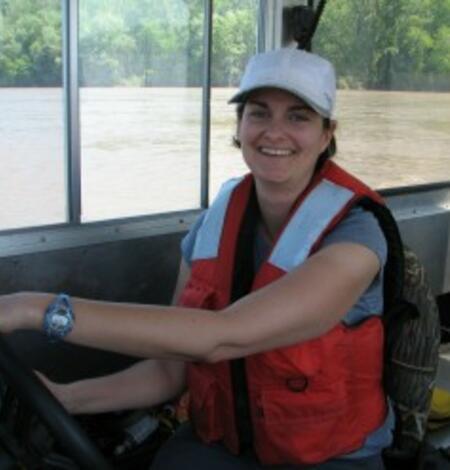The Williamson Family Colloquium Series: Nov 3rd
Bedform distributions and dynamics in a large, channelized river: Implications for benthic ecological processes
Sand bedforms are fundamental habitat elements for benthic fish in large, sand-bedded rivers and are hypothesized to provide flow refugia, food transport, and ecological disturbance. We explored bedform distributions and dynamics in the Lower Missouri River, Missouri, with the objective of understanding the implications of these features for benthic fish habitat, particularly for the endangered pallid sturgeon (Scaphirhynchus albus) and shovelnose sturgeon (Scaphirhynchus platorynchus) during their early life stages. We mapped bathymetry in a 3-kilometer-long reach of the highly engineered Lower Missouri River 22 times over a three-year period from 2019-2021 using a multibeam echosounder. Surveys included precise water surface and bed elevations over discharges ranging from 1,360-8,550 cubic meters per second. This included weekly surveys during a large flood event with a peak of 9,290 cubic meters per second in the spring and summer of 2019. Velocity was mapped with an acoustic Doppler current profiler during 11 of the 22 multibeam surveys. The dataset illustrates how bedforms are distributed in a typical Missouri River reach and how they evolve with changes in discharge. We measured a variety of bedform characteristics, including height, length, lee-slope angle, and crest orientation, and examined their relationship to larval sturgeon catch in the reach in 2020 and 2021. Bedform shapes are controlled by depositional environment and discharge and range in size from less than a meter in wavelength and amplitude to greater than 4 meters high and 75 meters long and generally have low angle lee-slopes. Small dunes were located in lower velocity regions on the inside of a bend and behind wing-dikes, as well as superimposed on larger dunes. Larger dunes were generally located in the channel thalweg and were associated with higher flow velocities. However, bedform size did not necessarily scale with discharge over the course of the 2019 flood, possibly due to sediment supply limitations and hysteresis effects. Changes in bedform size over the course of the flood event were most pronounced in the thalweg; less change in bedform size occurred behind wing dikes on the inside of channel bends, indicating some degree of habitat stability. Despite rarely getting caught in the thalweg, larval sturgeon drift in the thalweg until they are intercepted into off-channel habitats in wing dike fields, where they are caught in much higher numbers. Bedform orientations were affected by flow expansion around wing dikes, indicative of the role of wing dikes in influencing exchange of material between the thalweg and channel margins. Increased understanding of bedform distributions and dynamics will inform future sampling and habitat restoration designs for larval pallid sturgeon and contribute to increased understanding of their influence on benthic ecological processes.
Zoom Access
Join Zoom Meeting
https://umsystem.zoom.us/j/92872389824?pwd=QmZkNk5Fdy9qVnZNcmhZNjFqcjll…
Meeting ID: 928 7238 9824
Passcode: 291085
